|
Have a safe day!
Friday, Aug. 26
3:30 p.m.
DIRECTOR'S COFFEE BREAK - 2nd Flr X-Over
4 p.m.
Joint Experimental-Theoretical Physics Seminar - One West
Speaker: Avi Yagil, University of California, San Diego
Title: Searches for the Higgs Boson at CMS
Saturday, Aug. 27
8 p.m.
Fermilab Arts Series - Ramsey Auditorium
Blackthorn: Traditional Celtic band
Tickets: $16/$8
Monday, Aug. 29
PARTICLE ASTROPHYSICS SEMINARS WILL RESUME IN THE FALL
3:30 p.m.
DIRECTOR'S COFFEE BREAK 2nd Flr X-Over
4 p.m.
All Experimenters' Meeting - Curia II
Special Topics: NOvA Near Detector on the Surface (NDOS); Low-Energy Collider Run Request
Click here for NALCAL,
a weekly calendar with links to additional information.
Upcoming conferences
|
|
Friday, Aug. 26
- Breakfast: Chorizo burrito
- New England clam chowder
- Carolina burger
- Tuna casserole
- Smart cuisine: Dijon meatballs over noodles
- Bistro chicken & provolone panini
- Assorted sliced pizza
- Carved top round of beef*
*Carb-restricted alternative
Wilson Hall Cafe Menu
|
|
Friday, Aug. 26
Dinner
Closed
Wednesday, Aug. 31
Lunch
- Pork satay w/ peanut sauce
- Jasmine rice
- Pea pods
- Coconut cake
Chez Leon Menu
Call x3524 to make your reservation. |
|
Surprising neutrino measurements from Fermilab
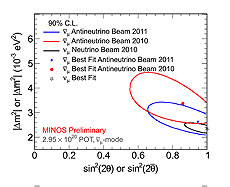 |
|
This graph demonstrates that the new MINOS antineutrino result (blue) is more precise than last year’s result (red), as reflected by the smaller oval, and the new result is in better agreement with the mass range of the 2010 neutrino result (black), reflected by the overlap of the blue and red ovals.
|
The physics community got a jolt last year when results showed for the first time that neutrinos and their antimatter counterparts, antineutrinos, might be the odd man out in the particle world and have different masses. This idea was something that went against most commonly accepted theories of how the subatomic world works.
A result released today (August 25) from the MINOS experiment at the Department of Energy’s Fermi National Accelerator Laboratory appears to quell concerns raised by a MINOS result in June 2010 and brings neutrino and antineutrino masses more closely in sync.
By bringing measurements of neutrinos and antineutrinos closer together, this new MINOS result allows physicists to lessen the potential ramifications of this specific neutrino imbalance. These ramifications include: a new way neutrinos interact with other particles, unseen interactions between neutrinos and matter in the earth and the need to rethink everything known about how the universe works at the tiniest levels.
“This more precise measurement shows us that these particles and their antimatter partners are very likely not as different as indicated earlier. Within our current range of vision it now seems more likely that the universe is behaving the way most people think it does," said Rob Plunkett, Fermilab scientist and co-spokesman of MINOS. “This new, additional information on antineutrino parameters helps put limits on new physics, which will continue to be searched for by future planned experiments.”
Read more
|
A beach in the sky - Aug. 22
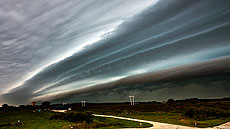 |
It stormed over Fermilab most of Monday, Aug. 22. This was the view from the training center facing Wilson Hall. Photo: Marty Murphy, AD |
|
|
|
Z-prime search may hurdle Higgs hunt
From Duke University's newsroom,
Aug. 25, 2011
If you're bummed about humanity's biggest accelerator not producing a Higgs particle yet, maybe the latest effort to find a Z-prime will make you feel better.
The new results can't claim a discovery of this sub-atomic particle, a gauge boson. But Duke physicist Ashutosh Kotwal says his team is narrowing in on this less press-frenzied particle, which, if discovered, means our understanding of particle physics would need a few revisions.
Physicists have been looking for Z-prime just as they have the Higgs, by slamming fast-moving particles into each other at the Large Hadron Collider, or LHC, in Europe.
Scientists are interested in predicted particles like Z-prime because they could fix holes in the current model, the Standard Model, that explains particle physics.
One of the biggest holes of the model is its inability to explain the origin of mass. The Higgs boson is supposed to correct this, but there are other problems, such as why neutrinos oscillate, why there is more matter than antimatter in the universe or where dark matter and dark energy originate.
Read more
|
Explainer: Standard Model of particle physics
From The Conversation, Aug. 25, 2011
The “traditional” beauty of theoretical physics is its equations. If we want to describe something, or the way something behaves, we can write down a relation between some properties we think that thing will obey.
The simplicity and symmetry of these equations – to someone who understands them – is amazingly beautiful.
Given the mass of a ball, the height, angle, and strength with which it is thrown, physics will tell you the path the ball with take through the air, how long it will be in the air for, and how far away and how hard it will hit the ground.
Physics can fully describe this system with just a few simple properties.
But what if you want to describe the ball itself? We could say it’s red, but what does that really mean? To describe colour you need to consider the light being reflected from the ball.
You could say the ball’s made of plastic, but you need to describe the molecules.
Read more
|
|
Melting mesons
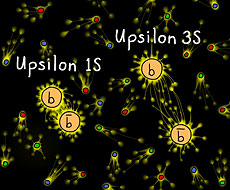 |
|
Since the bottom quarks (b and b) inside the Upsilon 1S (left) are held together more tightly than in the Upsilon 3S (right), the Upsilon 1S is less likely to fall apart when clobbered by quarks and gluons in a hot plasma.
|
There have been some hot days this summer; not quite hot enough to cook an egg on the sidewalk, but hot enough to bake cookies in a car. But we don’t need a thermometer to quantify temperature. Besides baking in our cars, we can note what melts and what doesn't. When nuclei collide in the LHC, the temperatures produced are hot enough to melt subatomic particles called mesons. They are a million times hotter than the center of the sun, just as the center of the sun is many thousands of times hotter than summer in Chicago.
The upsilon 1S, 2S and 3S are a family of mesons, all of which are made of a bottom quark and antiquark, bound by a stream of gluons. In an analysis of lead-nucleus collisions, CMS scientists saw far fewer upsilon 2S and 3S mesons relative to upsilon 1S. This is what we expect if the temperature were hot enough to melt them.
For one month toward the end of each year, the LHC collides lead nuclei instead of protons. Lead nuclei are made of more than 200 protons and neutrons; when they collide, there are so many interactions in a small region of space that the debris mixes and becomes fluid, called quark-gluon plasma. If the plasma is hot enough, the whirlwind of quarks and gluons can knock apart the bottom and antibottom quarks of an upsilon meson. This is called melting, as explained by this analogy of melting ice: molecules of hot air can knock apart the bonds holding water molecules together in ice. However, upsilon mesons are much smaller and harder to break up than ice.
The CMS analysis revealed that 60 percent of upsilon 1S mesons and almost 90 percent of upsilon 2S and 3S seem to disappear when immersed in the hot aftermath of lead nucleus collisions. The fact that upsilon 2S and 3S are more suppressed is the most interesting part: scientists believe that it is because the 2S and 3S are more loosely bound than the 1S. Because the bottom quarks of the upsilon 2S and 3S dangle more loosely, less force is needed to knock them apart.
This effect introduces a new way to study quark-gluon plasmas—a new state of matter so hot and so short-lived that subatomic particles are the only thermometer.
—Jim Pivarski
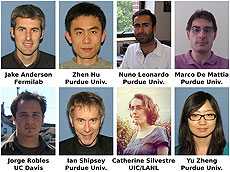 |
| The U.S. physicists pictured above played a major role in this analysis.
|
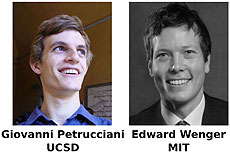 |
|
Upsilon mesons are identified by tracks of the particles they decay into. The above physicists made sure that tracking algorithms work well in collisions of lead nuclei. |
|
|